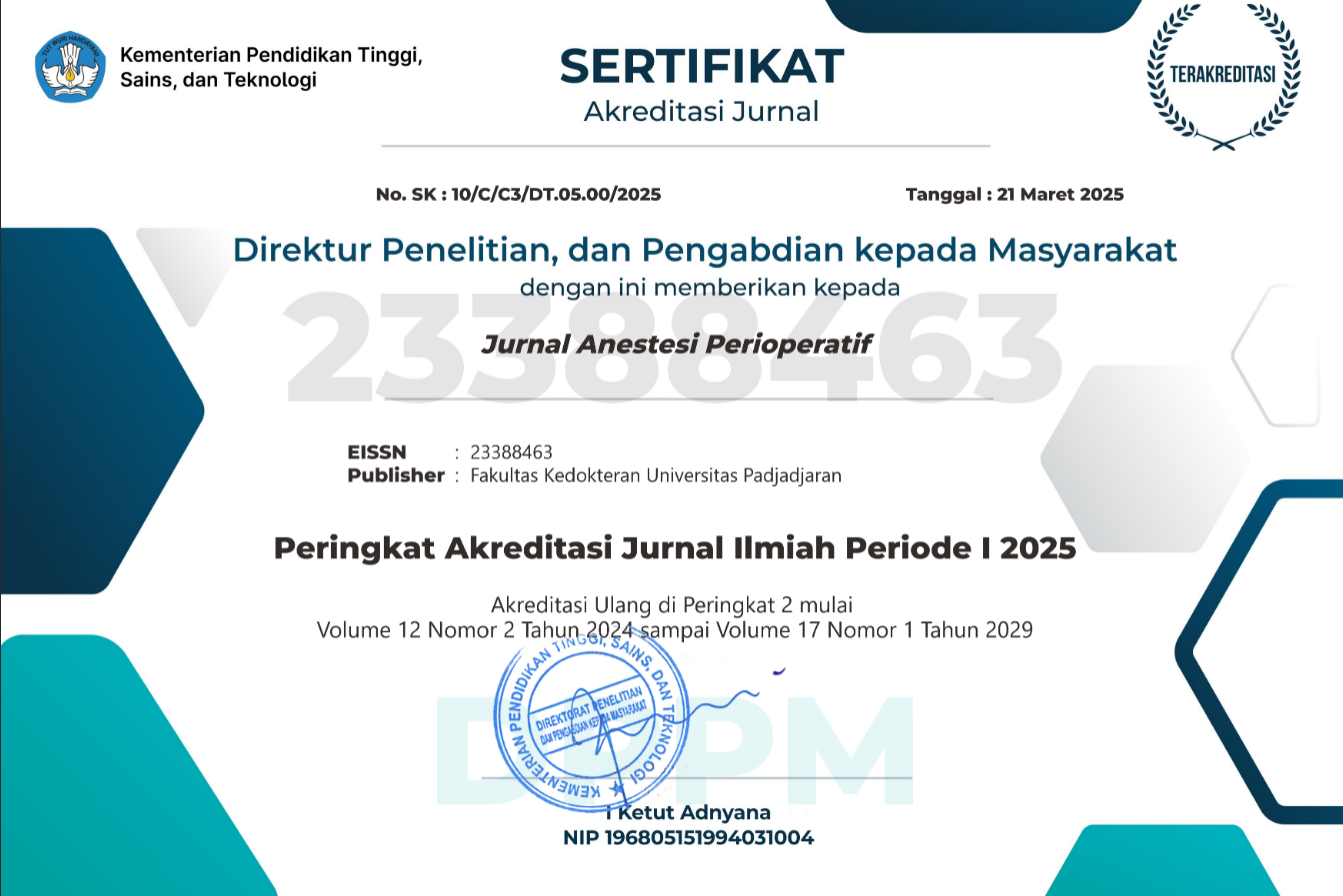Perbedaan Kebutuhan Morfin PCA Pascalaparatomi antara Infiltrasi Ketamin dan Infiltrasi Levobupivakain
Abstract
Differences in Post-laparotomy PCA Morphine Needs between Ketamine Infiltration and Levobupivacaine Infiltration
Inadequate acute pain management is a risk factor for chronic pain and other complications. Laparotomy is a painful procedure with severe acute pain. Patient controlled analgesia (PCA) morphine use in acute pain control is promoted for efficiency and effectiveness. Wound infiltration is also effective in reducing acute pain. This study aimed to determine the effectiveness of ketamine and levobupivacaine wound infiltration in reducing the need for post-laparotomy PCA morphine. This study used a single-blind randomized clinical trial at RSUD Dr. Moewardi Surakarta on 30 subjects who underwent laparotomy and met the inclusion criteria. The samples were divided into three groups: wound infiltration with levobupivacaine, wound infiltration with ketamine, and wound infiltration with saline. All patients received standard general anesthetic treatment and were then evaluated for the total use of PCA morphine. It also assessed the effects of postoperative nausea-vomiting and the side effects of wound infiltration. The average PCA morphine use in the ketamine group was 2.20+1.32 mg. In the Levobupivacaine group was 5.80+1.03 mg, and in the NaCl group was 10.00+1.76 mg. Kruskal Wallis statistical test obtained p-value=0.000 (p<0.05), which means that there was a significant difference in PCA morphine use after 24 hours between the three groups. No complication occurred with the three-group wound infiltration. Thus, there is a significant difference in the use of PCA morphine between wound infiltration with ketamine and wound infiltration with levobupivacaine and with saline infiltration. Ketamine wound infiltration can be used effectively to reduce post-laparotomy pain.
Keywords
Full Text:
PDFReferences
Macres S, Moore P, Fishman S. Acute pain management. Edisi ke-6. Dalam: Barash P, Cullen B, Soelting R, penyunting. clinical anesthesia. Philadelphia: Lippincot William; 2009. hlm. 1405–40.
Sarantopoulos C. Management of neuropathic pain. Pain Medicine. Mosby Inc.; 2006. hlm. 132–14.
McDonald DD. Older adults’ pain descriptions. Pain Manag Nurs. 2009;10(3):142–8.
Mowat I, Johnson D. Acute pain management: assessment and management [Internet]. Anaesthesia tutorial of the week 295. 2013 [diunduh 19 Agustus 2017].Tersedia dari: http://www.totw.anaesthesiologists.org/
Craft J. Patient-controlled analgesia: is it worth the painful prescribing process?. Baylor Univ Med Cent Proc. 2010;23(4):434–8.
Silvasti M, Pitkä̈nen M. Patient-controlled epidural analgesia versus continuous epidural analgesia after total knee arthroplasty. Acta Anaesthesiol Scand. 2001;45(4):471–6.
Morgan G, Mikhail M, Murray M. Local anesthetics clinical anesthesiology. Edisi ke-4. New York: Mc Graw Hill Lange Medical Books; 2006.
Deval NS, Jethava D, Sachdev S, Jethava DD. A Comparative study of preincisional infiltration of levobupivacaine 0.2 % and ropivacaine 0.375 % for postoperative analgesia after abdominal surgery under general anesthesia. Int J Med Res Prof. 2018;4(1);582–7.
Safavi M, Honarmand A, Nematollahy Z. Pre-incisional analgesia with intravenous or subcutaneous infiltration of ketamine reduces postoperative pain in patients after open cholecystectomy: a randomized, double-blind, placebo-controlled study. Pain Med. 2011;12:1418–26.
Honarmand A, Safavi M, Karaky H. Preincisional administration of intravenous or subcutaneous infiltration of low-dose ketamine suppresses postoperative pain after appendectomy. J Pain Res. 2012;5:1–6.
Kwok RFK, Lim J, Chan MTV, Gin T, Chiu WKY. Preoperative ketamine improves postoperative analgesia after gynecologic laparoscopic surgery. Anesth Analg. 2004;98(4):1044–9.
Hadi BA, Daas R, Zelkó R. A randomized, controlled trial of a clinical pharmacist intervention in microdiscectomy surgery-low dose intravenous ketamine as an adjunct to standard therapy. Saudi Pharm J. 2013;21(2):169–75.
Nesher N, Serovian I, Marouani N, Chazan S, Weinbroum AA. Ketamine spares morphine consumption after transthoracic lung and heart surgery without adverse hemodynamic effects. Pharmacol Res. 2008;58(1):38–44.
Laskowski K, Stirling A, McKay WP, Lim HJ. A systematic review of intravenous ketamine for postoperative analgesia. Can J Anesth. 2011;58(10):911–23.
Zakine J, Samarcq D, Lorne E, Moubarak M, Montravers P, Beloucif S, dkk. Postoperative ketamine administration decreases morphine consumption in major abdominal surgery: a prospective, randomized, double-blind, controlled study. Anesth Analg. 2008;106(6):1856–61.
Jha AK, Bhardwaj N, Yaddanapudi S, Sharma RK, Mahajan JK. A randomized study of surgical site infiltration with bupivacaine or ketamine for pain relief in children following cleft palate repair. Paediatr Anaesth. 2013;23(5):401–6.
Mohamed SA, Sayed DM, El Sherif FA, Abd El-Rahman AM. Effect of local wound infiltration with ketamine versus dexmedetomidine on postoperative pain and stress after abdominal hysterectomy, a randomized trial. Eur J Pain. 2018;22(5):951–60.
Abdallah NM, Salama AK, Ellithy AM. Effects of preincisional analgesia with surgical site infiltration of ketamine or levobupivacaine in patients undergoing abdominal hysterectomy under general anesthesia; A randomized double blind study. Saudi J Anaesth. 2017;11(3):267–72.
Lepner U, Goroshina J, Samarütel J. Postoperative pain relief after laparoscopic cholecystectomy: a randomised prospective double-blind clinical trial. Scand J Surg. 2003;92(2):121–4.
Sigtermans MJ, van Hilten JJ, Bauer MCR, Arbous MS, Marinus J, Sarton EY, et al. Ketamine produces effective and long-term pain relief in patients with complex regional pain syndrome type 1. Pain. 2009;145(3):304–11.
DOI: https://doi.org/10.15851/jap.v9n3.2493
Article Metrics
Abstract view : 1064 timesPDF - 350 times
This Journal indexed by

JAP is licensed under a Creative Commons Attribution-NonCommercial 4.0 International License
View My Stats



